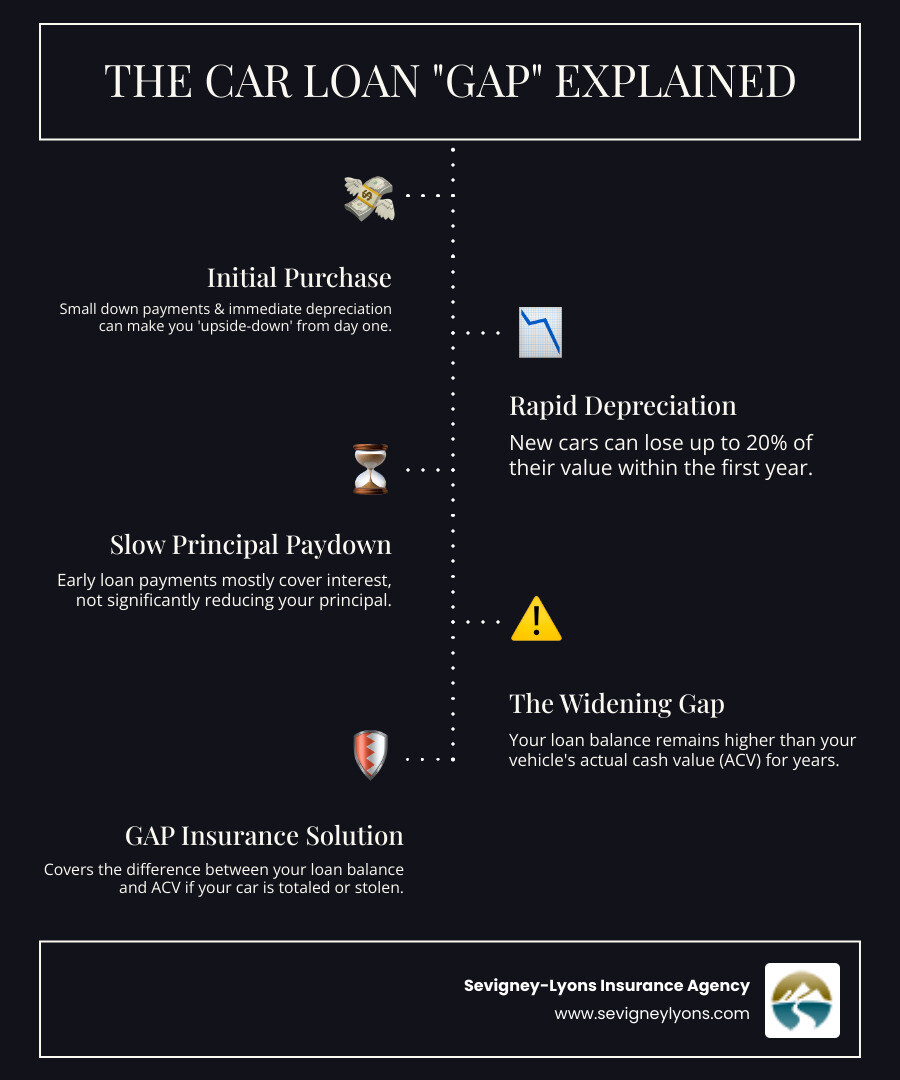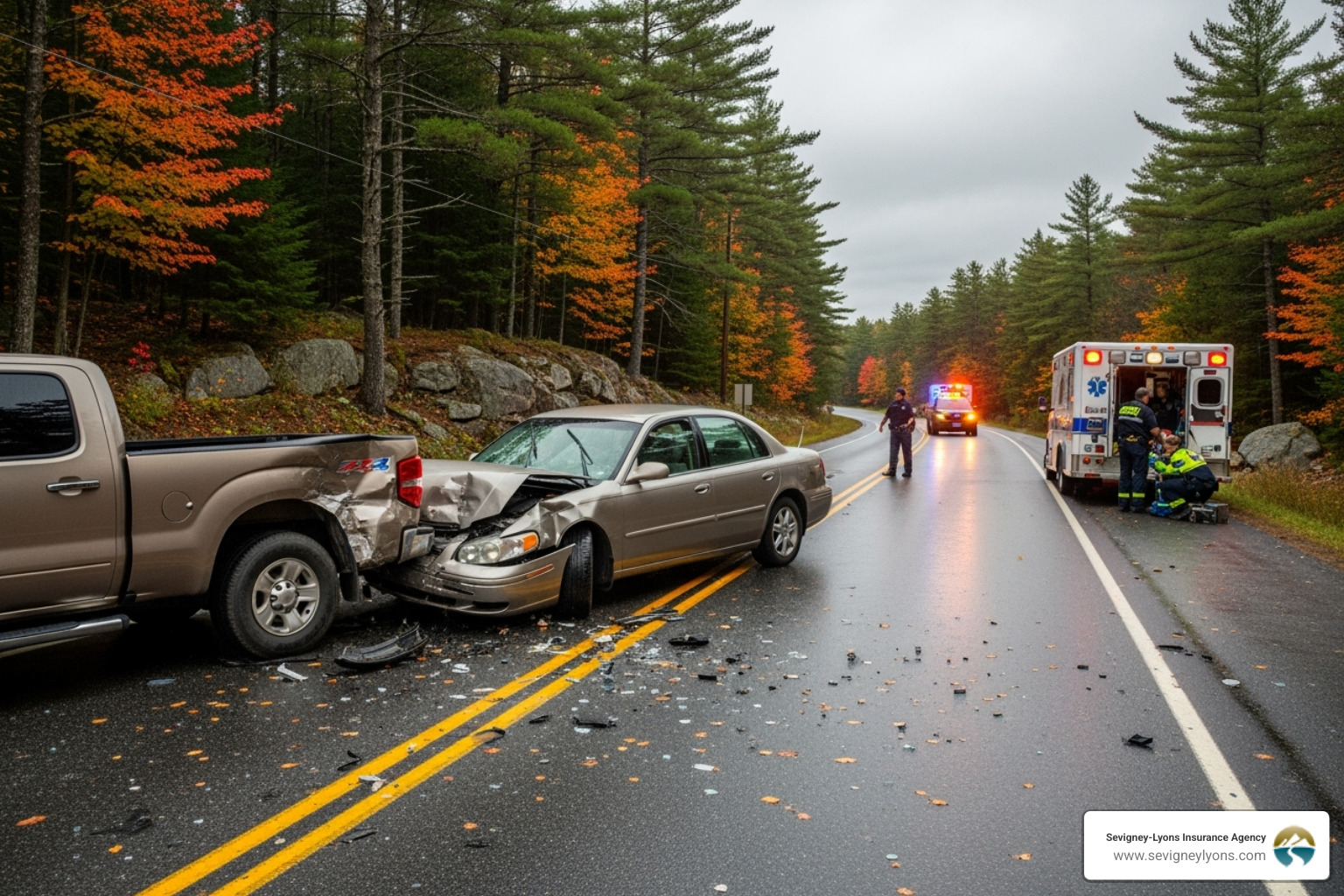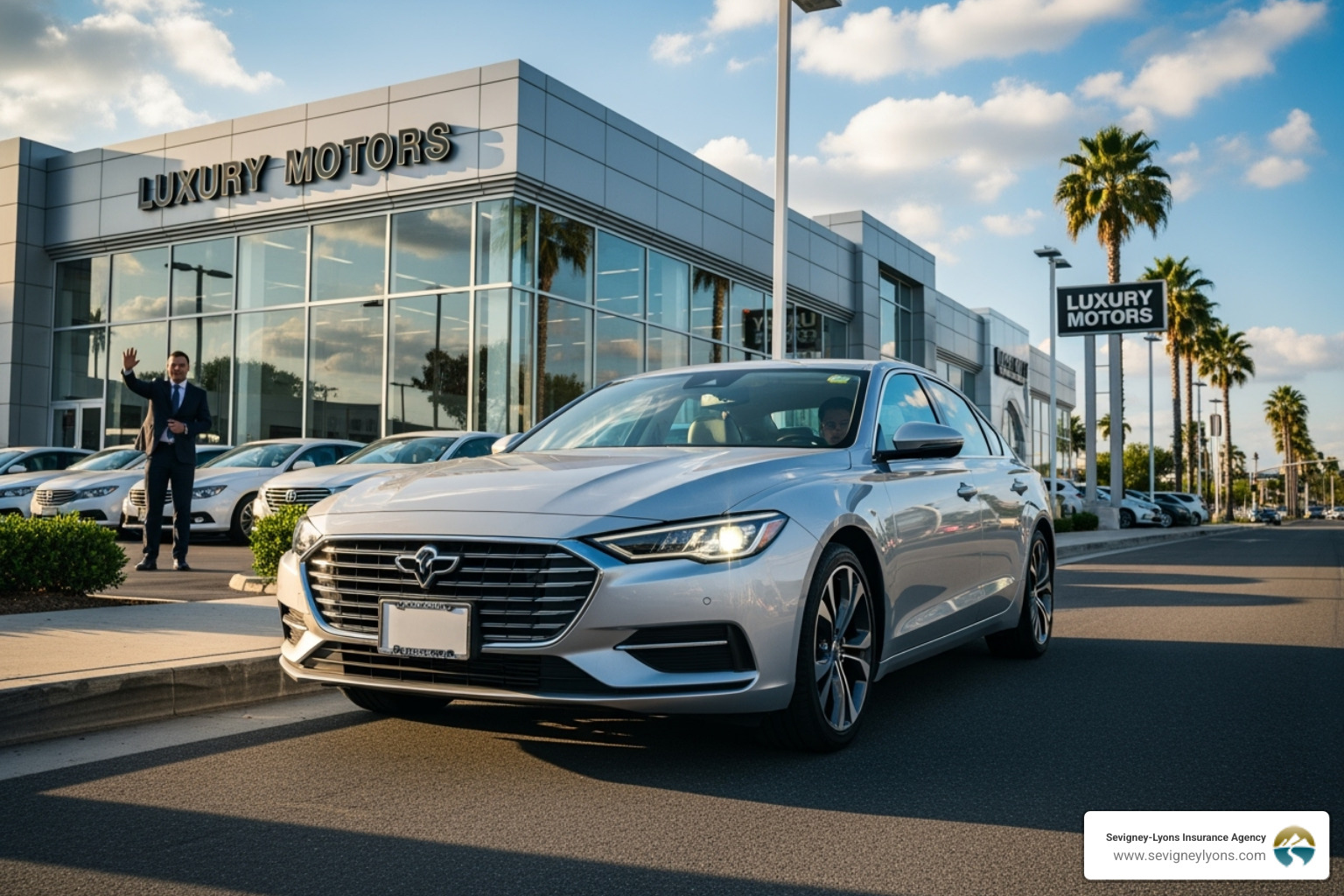Blog Content
Why Gap Insurance for a Car Loan Matters in Maine
Gap insurance for a car loan protects you from owing money on a vehicle you can no longer drive. When your car is totaled or stolen, your standard auto insurance pays the vehicle's current value, which is often less than what you still owe on your loan. This coverage, also known as Guaranteed Asset Protection (GAP), pays the difference.
Here's the problem: cars can lose up to 20% of their value in the first year. If you financed $30,000, your car might only be worth $24,000 after 12 months, while you could still owe $28,000. Without GAP insurance, a total loss leaves you responsible for that $4,000 "gap."
This is a common risk for drivers in Maine, from Wells to Biddeford, especially if you:
- Made a small down payment
- Have a loan term longer than 60 months
- Drive a vehicle that depreciates quickly
Many Maine drivers find themselves in this "upside-down" situation without realizing it. This guide walks you through everything you need to know about Gap insurance for a car loan so you can make an informed decision and protect yourself from this common financial risk.

What is GAP Insurance and How Does It Work?
GAP insurance for a car loan—Guaranteed Asset Protection—covers the financial gap between what you owe on your car loan and what your insurance will pay if the vehicle is totaled or stolen.
Here's how it works: Your standard auto policy pays your vehicle's Actual Cash Value (ACV) at the time of a total loss. Because new cars depreciate quickly, your ACV is often thousands less than your remaining loan balance. You are then "upside down" on your loan, owing more than the car is worth.
GAP insurance for a car loan pays this difference directly to your lender. Some policies even cover your insurance deductible. Without it, you'd be stuck making payments on a car you can't drive while also needing to find a replacement. For more details, the Consumer Financial Protection Bureau offers helpful resources.

A Real-World Example of GAP Insurance in Action
Imagine you buy a new SUV in Kennebunk for $40,000 with a small down payment. Eighteen months later, it's declared a total loss.
- Remaining Loan Balance: $35,000
- Car's Actual Cash Value (ACV): $28,000
- Insurance Payout (after $500 deductible): $27,500
Without GAP coverage, you'd owe your lender a $7,500 shortfall out-of-pocket for a car that's gone. With GAP insurance for a car loan, that $7,500 gap is covered, and your loan is paid off.
What GAP Insurance Typically Excludes
GAP insurance for a car loan is specific protection. It does not cover:
- Overdue loan payments, late fees, or other financial penalties.
- The cost of extended warranties or other add-ons rolled into your loan.
- The value of aftermarket modifications like custom wheels or sound systems.
- Negative equity from a previous loan that you rolled into your current one (unless your policy specifically includes it).
- Partial damage that can be repaired; it only applies to a total loss.
- Your down payment or trade-in equity.
Think of it as a safety net for one specific scenario: when you owe more than your totaled or stolen car is worth. For a broader look at coverage, see our guide on Maine Auto Full Coverage vs. Gap Insur.
Who Needs Gap Insurance for a Car Loan and Why?
For many Maine drivers, Gap insurance for a car loan is the difference between a financial setback and a financial disaster. If there's a chance you might owe more on your car than it's worth, you should seriously consider it.
This "upside-down" situation is common. New cars can lose 20% of their value in the first year and up to 60% over five years. If your vehicle is totaled during this time, you're left paying off a loan for a car you no longer have. Gap insurance for a car loan protects you from this exact scenario by covering the difference between your insurance payout and what you still owe.

Scenarios Where GAP Insurance is Highly Recommended:
If any of these describe your financing arrangement, you should strongly consider Gap insurance for a car loan:
- Making a down payment of less than 20%: A small down payment means you have little to no equity, putting you underwater on your loan almost immediately.
- Choosing a loan term of 60 months or longer: Longer loans build equity very slowly while your car's value continues to drop, extending your financial risk.
- Leasing a vehicle: Many leases include GAP coverage, but if yours doesn't, you should add it.
- Rolling negative equity from a previous loan into your new one: This inflates your loan amount beyond your new vehicle's value from day one.
- Buying a vehicle that depreciates quickly: Luxury and certain other models lose value faster, creating a wider gap more quickly.
You Made a Small Down Payment
Putting down less than 20% creates a financial vulnerability the moment you drive off the lot in Biddeford or Wells. Since a new car's value can drop by 20% in the first year, a smaller down payment means you're immediately upside-down. If your car were totaled, your standard insurance would pay its current value, leaving you to cover the difference on your loan. Gap insurance for a car loan is designed to protect you from this exact situation.
You Have a Long-Term Car Loan
Longer loans (60+ months) make monthly payments manageable but also mean you're vulnerable for a longer period. In the early years, most of your payment goes to interest, not principal, so your loan balance decreases very slowly. Meanwhile, your car's value depreciates steadily. This mismatch can last for years, leaving you with a significant gap if your car is totaled. Gap insurance for a car loan bridges that gap, ensuring your payment plan doesn't leave you financially exposed.
For more on comprehensive coverage, check out our Full Coverage Automobile Insurance Guide.
The Cost vs. Benefit: Is GAP Insurance Worth It?
Deciding on Gap insurance for a car loan comes down to a simple comparison: a small, known cost versus a potentially huge, unexpected debt. For most Maine drivers financing a newer vehicle, the math is reassuring.
Imagine your car is totaled in a Wells winter storm. You still owe $28,000, but its value is only $22,000. Without GAP coverage, you'd be on the hook for that $6,000 difference. With Gap insurance for a car loan, which might have cost just a few hundred dollars, that debt is covered. The peace of mind knowing you're protected from this scenario while driving through Kennebunk or Biddeford is invaluable.

How Much Does Gap insurance for a car loan Cost?
Gap insurance for a car loan is surprisingly affordable. When added to your auto policy, it typically costs an extra $40 to $60 per year. If purchased from a dealership, it's usually a one-time fee of $350 to $800.
Many drivers roll this cost into their car loan, which can add between $5 to $15 a month to loan payments. Compared to a potential gap of several thousand dollars, this small cost is smart financial planning. Your insurance company can usually offer better rates than a dealership.
When is GAP Insurance Not Necessary?
While valuable for many, Gap insurance for a car loan isn't always needed. You likely don't need it if:
- You made a large down payment (20% or more). This creates instant equity, providing a buffer against depreciation.
- Your loan term is short (48 months or less). You build equity much faster, closing the potential gap quickly.
- You paid cash or have no loan. Without a loan, there is no gap to cover.
- You have significant positive equity. If your car is worth more than your remaining loan balance, you no longer need GAP coverage.
If you're unsure, we can help you review your loan details to make an informed decision. For more guidance, check out our article on Do I Need Full Coverage Auto Insurance.
How to Purchase and Manage Your GAP Policy in Maine
Acquiring GAP insurance for a car loan in Maine is straightforward, but knowing your options can save you money. You can typically buy it from the car dealership or your auto insurance company. While Maine doesn't mandate GAP coverage, understanding your choices is key. For more on state requirements, see our guide to Maine Car Insurance Laws 2025.
Comparing GAP Insurance Sources
Where to Buy Gap insurance for a car loan
Car dealerships offer GAP coverage for convenience, often rolling the cost into your loan. However, this is usually the most expensive option, as the price is higher and you'll pay interest on it.
Your insurance company is typically the most cost-effective choice. Adding GAP insurance for a car loan to your auto policy often costs just $40-$60 per year and is paid with your premium, with no interest. As an independent agency, Sevigney-Lyons can help you find a competitive rate.
Red Flags to Watch For at the Dealership
When buying GAP insurance for a car loan, be an informed consumer. Watch for these red flags:
- High Prices: Quotes over $800 are a sign of a significant markup.
- Claims it's Mandatory: While a lender may require it, it's not required by state law. You can buy it from any source.
- Vague "Waiver Agreements": Ensure you are buying a regulated insurance product, not an unregulated waiver with unclear terms.
- Pressure Tactics: Don't feel rushed. It's okay to say you want to check with your insurance agent first.
Canceling or Getting a Refund for GAP Insurance
You can and should cancel your GAP insurance for a car loan if you no longer need it. This often happens if you pay off your loan early, sell the car, or refinance. Since the coverage is tied to the original loan, it becomes unnecessary.
To cancel, contact the seller (dealership or insurer) and provide proof that the loan is closed or the car is sold. You are typically entitled to a prorated refund for the unused portion of your premium. A small cancellation fee may apply, but getting a refund for coverage you don't need is always a smart move.
Frequently Asked Questions about GAP Insurance
We talk with Maine drivers about GAP insurance for a car loan every day. Here are answers to the most common questions.
Is GAP insurance mandatory for a car loan or lease in Maine?
No, Maine state law does not require GAP insurance for a car loan. However, your lender or leasing company often will require it as a condition of your financing, especially with a small down payment or long loan term. They do this to protect their investment. Always verify this requirement in your loan agreement, and remember that even if it's required, you can purchase it from your insurer instead of the dealership.
What's the difference between GAP insurance and a waiver of depreciation?
These are two different products. GAP insurance for a car loan pays off your lender by covering the gap between your car's value and your loan balance. Its goal is to eliminate your debt.
A waiver of depreciation (or replacement cost coverage) helps you by paying to replace your totaled new car with a brand-new one of the same make and model, ignoring depreciation. Its goal is to get you a new vehicle. Both are valuable but serve different purposes.
Do I need GAP insurance if I already have full coverage?
Yes, in many cases you still need it. "Full coverage" (comprehensive and collision) pays for your car's Actual Cash Value (ACV) at the time of the loss. It does not care what you owe on your loan. If your loan balance is higher than the car's ACV, full coverage will not pay off your loan.
That's the exact situation GAP insurance for a car loan is designed for. It works with your full coverage to protect you. Your collision/comprehensive policy pays the car's value, and GAP pays the remaining loan balance. To learn more, see our guide on Full Coverage Auto Insurance Maine.
Conclusion
For many Maine drivers, GAP insurance for a car loan is a critical financial safety net, not just an optional add-on. It protects you from the reality of vehicle depreciation, ensuring a total loss doesn't leave you with debt for a car you no longer own. By understanding what it is, who needs it, and how to buy it smartly, you can protect your investment and your peace of mind.
At Sevigney-Lyons Insurance Agency, we have deep roots in Southern Maine, serving communities from Wells to Portland. We are committed to helping our neighbors find custom insurance solutions that fit their lives. If you have questions about GAP insurance for a car loan or any other aspect of your auto coverage, our experienced team is here to help.
Don't let the "gap" catch you by surprise. Contact us today for personalized advice to ensure you're protected on the road.

Ready to secure your peace of mind on the road? Find the Best Auto Insurance Coverage in Maine with Sevigney-Lyons.







